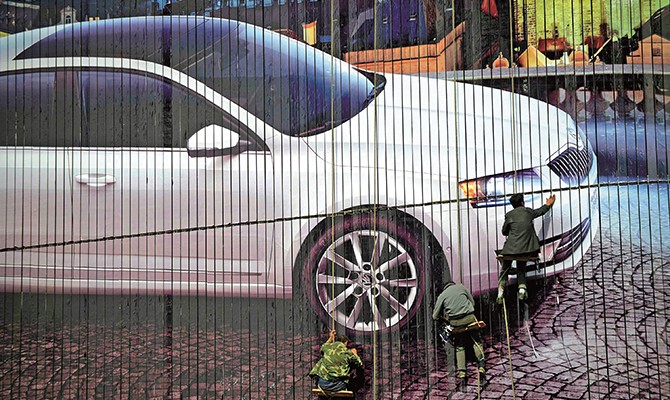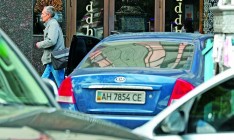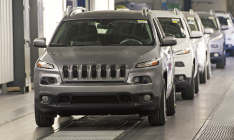Business
CollapseUkraine’s car dealers rapidly closing shop

The drop in car sales in Ukraine is forcing many market players to sell their businesses. There are dozens of offers for the sale of car dealerships on realtor websites and online marketplaces, such as olx.ua, denua.com, fre.com.ua. The majority of them are located in Kyiv and Odesa, but there are also offers from Kirovohrad, Chernivtsi, Chernihiv, Uzhgorod, Kriviy Rih, Kherson and Kremenchuk. Not only car dealerships are offered for sale, but also auto repair shops, car washes and gas stations. The prices range from US $1 mn to US $10 mn.
Pulling to the bottom
One of the owners of a car dealership in Odesa with a total space of over 6,000 sq m that was put up for sale told Capital that the business is not bringing in the expected returns, which is why he is selling it. He specified that at the moment his company does not have an official agreement with car importers, though it is quite difficult to operate in a declining market without one. At the same time, he complained that official car importers are not particularly willing to make contacts with independent (so-called semi-legal) dealers.
Artem Tkachenko, CEO of ViDi Auto City, which manages 18 car dealership centers, also told Capital that mostly independent car dealers are selling their dealerships and complexes, while chain operators are more stable. Commercial Director of Hyundai Motor Ukraine Hennadiy Chetvertukhin agrees, adding that there have been many grey dealers in Ukraine up until recently, who do not have stable channels of supply. Tkachenko calculated that the share of small dealers accounted for 20-30% of all car sales in the country. He says dealers went through difficulties operating on the market, when 220,000 cars were sold per year (in 2013), while now the situation is drastic and the 50% plus decline in sales does not add optimism. As a reminder, in January-September 2014 all market players managed to sell just over 73,000 new vehicles, which is 53% less than in the same period of 2013.
Chetvertukhin believes that banks are forcing car dealers to sell their business because construction of the majority of dealerships was mainly done on borrowed funds. However, the advisor of the chairman of Ukrgazbank Stanislav Shlapak told Capital that borrowers in this sector indeed have problems, though banks are willing to propose debt restructuring in such cases. The problem is that many owners of such car dealerships do not see any prospects of fast recovery of the market and the only way out of the situation is to sell their assets in order to pay off their debts, said Shlapak. The banks are trying to not use the “pawn shop” method to resolve the issue, though these days it is virtually impossible to find buyers for such car dealerships, he says.
Thresholds
Some market players claim that the minimum threshold at which a small dealer can make ends meet is the sale of at least 100 cars per year. Today, however, a number of car dealerships in small towns sell two cars a month at best, which means they hardly break even, experts say. Furthermore, the expenses of such companies continue to rise.
The car dealership network in Ukraine formed on the basis of 2008 indicators, when more than 660,000 units were sold, the information analytical group AUTO-Consulting claims. The opening of new dealerships did not stop even after sales collapsed in 2009-2012. Expecting a growth in sales and recovery of the past indicators market players continued to develop in new regions. However, a new wave of the crisis in 2014 disrupted their plans.
Life saver
Tkachenko says that major car dealerships manage to survive on the market thanks to the servicing of vehicles and the sale of spare parts. “In our company all expenses are covered mainly due to earnings from provision of maintenance services,” he said. A company may not sell cars, but it still continues to function, said the expert.
The importance of car maintenance shops increased substantially during the crisis, comments CEO of Renault Ukraine Yana Minenko, stressing that the company plans to continue to actively develop its maintenance services. She admits, however, that a decrease in demand has been observed in this segment.
Chetvertukhin says that car companies are trying to attract back clients, who left official car maintenance shops after the warranty period expired. “It is rather difficult to hold on to a client beyond the warranty period. That is why there are special programs of post-warranty maintenance, where the prices of services and spare parts are more attractive,” says the expert.
Renewal of opening dealerships will not happen soon. Market players are also finding it difficult to make forecasts. “We work with a chain, which ensured the sale of 20,000 cars in 2008. Taking into account that this year we will only be able to achieve a quarter of this volume, our company will not continue active development of the chain. This will happen when the market grows by at least four times from its current level,” says Minenko. “Our company is drafting a budget for 2015 and planning purchases based on the forecast of a market volume of 100,000 units,” says Tkachenko.
Chetvertukhin, however, believes that such indicators can be achieved only in a very optimistic scenario. Some players base their plans on the market volume of 70,000 units in 2015. Market players believe that such a state of affairs will stiffen competition and will lead to squeezing out other players from the market and growing sales of small-time operators.






 of the agreement of syndication with Financial Times Limited are strictly prohibited. Use of materials which refers to France-Presse, Reuters, Interfax-Ukraine, Ukrainian News, UNIAN agencies is strictly prohibited. Materials marked
of the agreement of syndication with Financial Times Limited are strictly prohibited. Use of materials which refers to France-Presse, Reuters, Interfax-Ukraine, Ukrainian News, UNIAN agencies is strictly prohibited. Materials marked  are published as advertisements.
are published as advertisements.